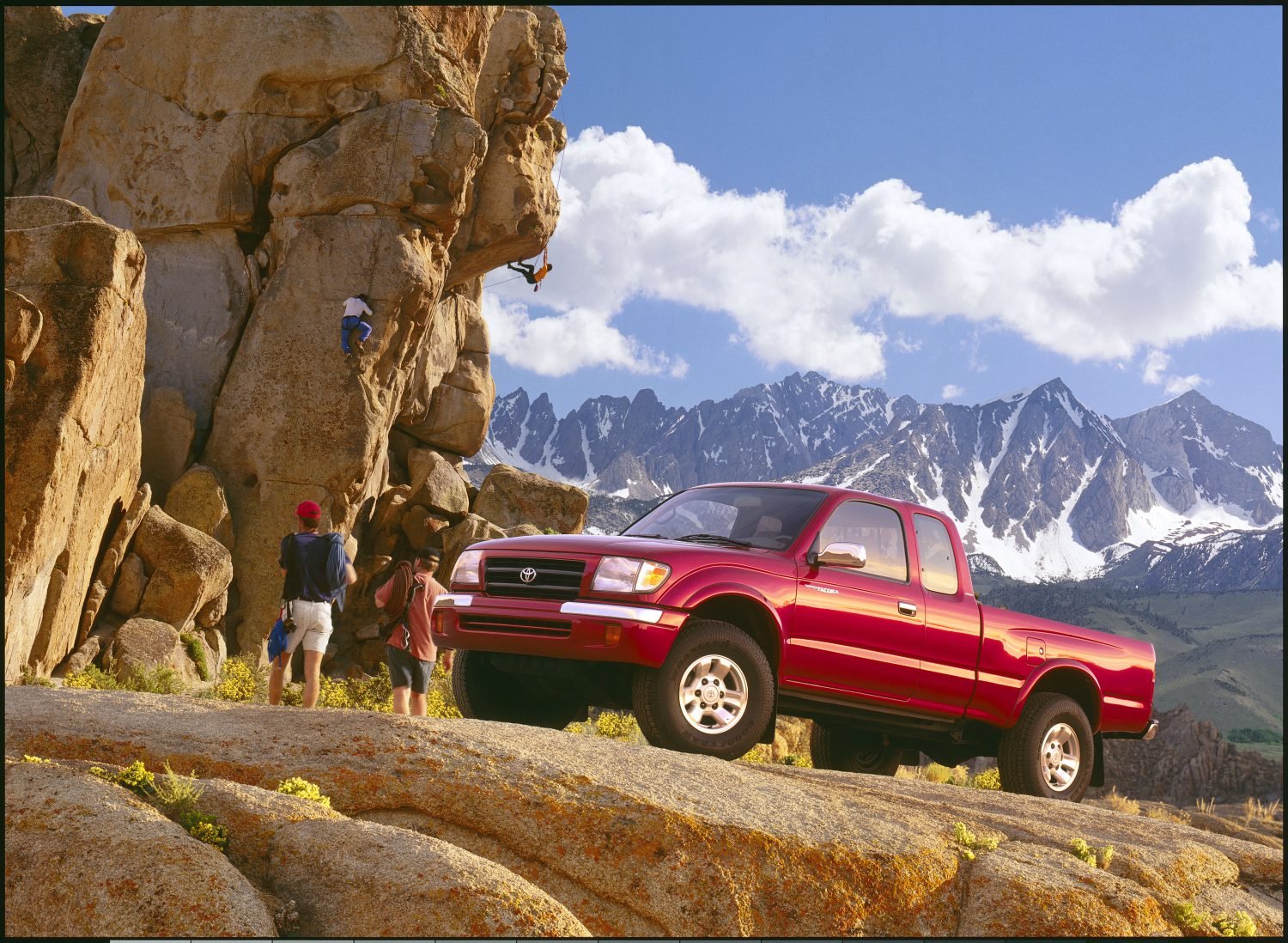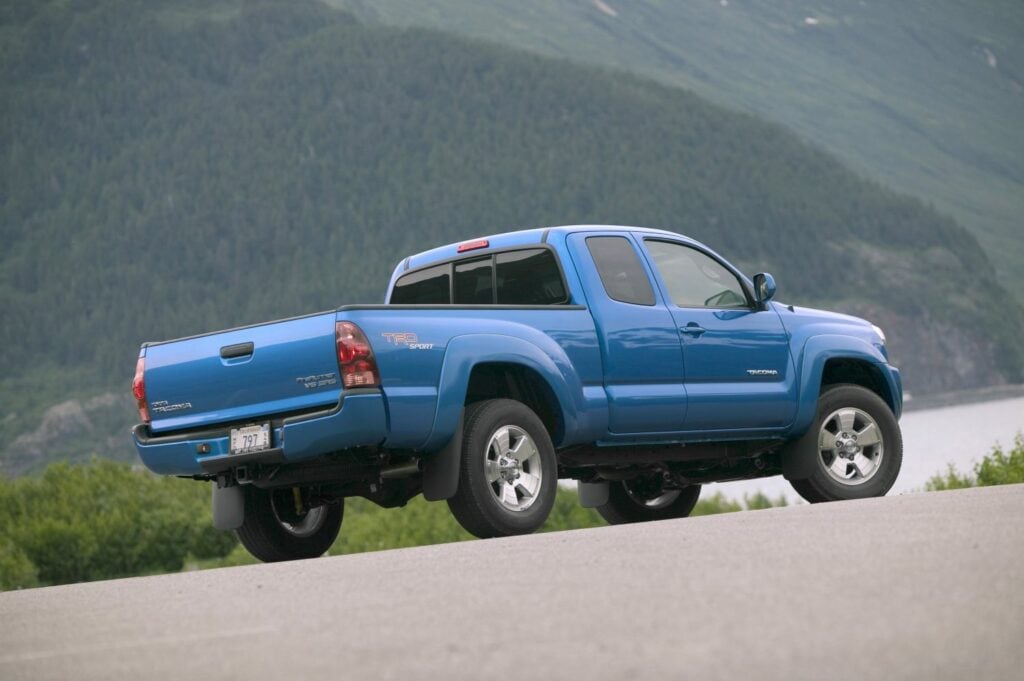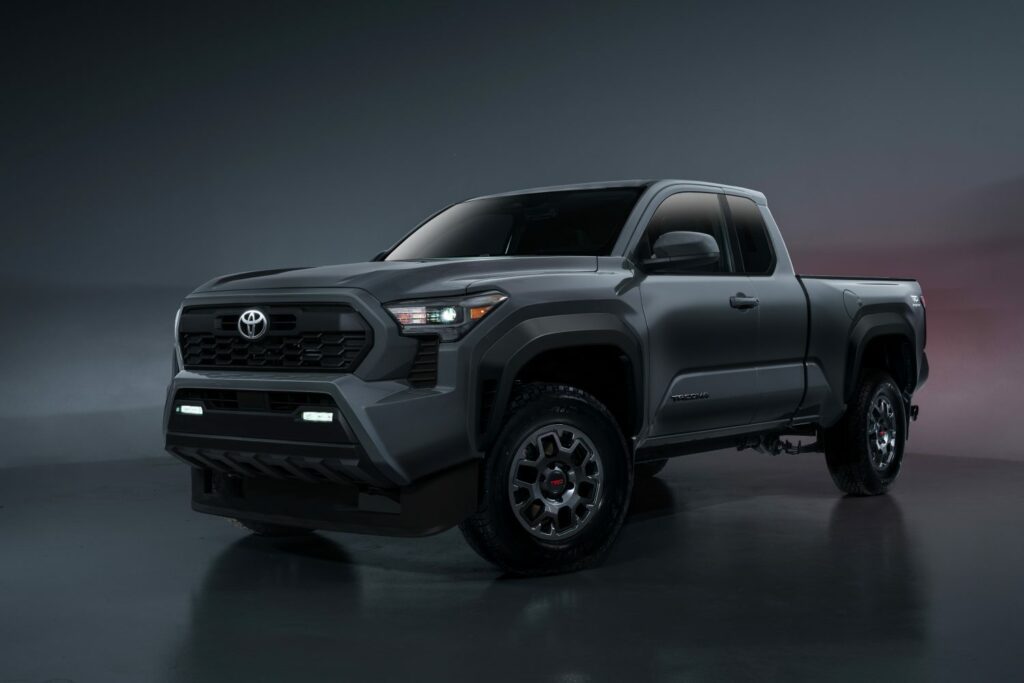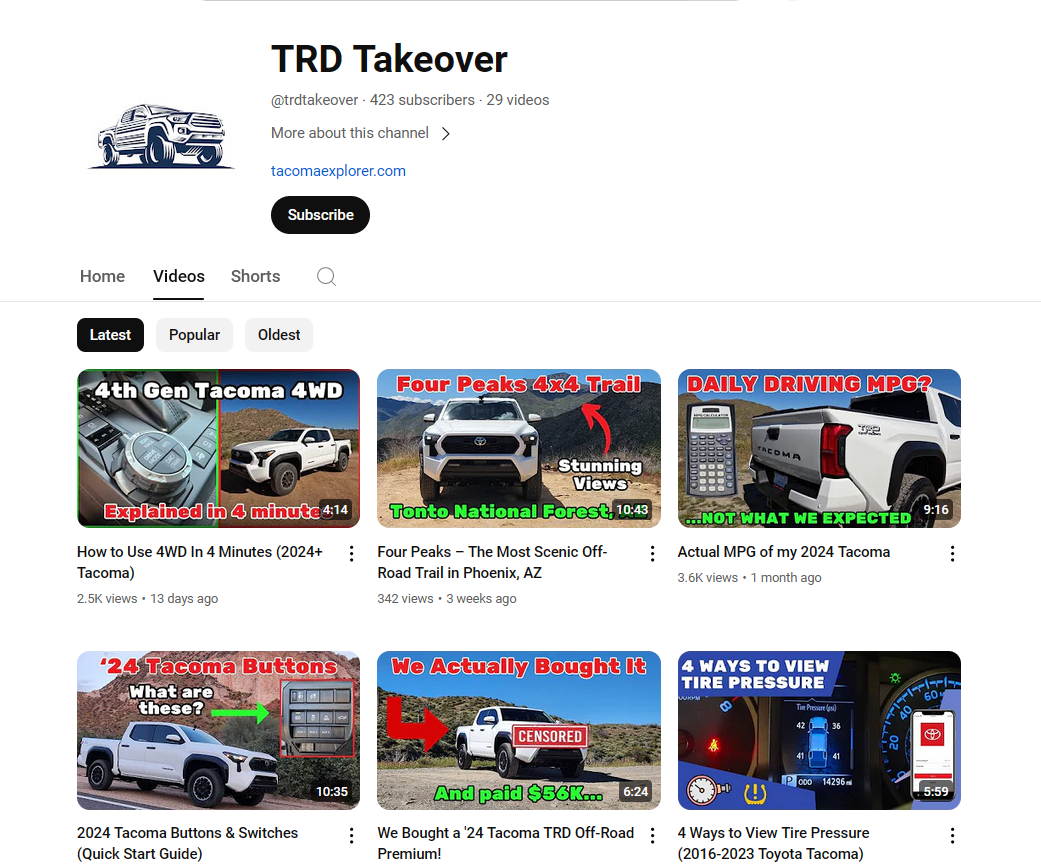History of the Tacoma PreRunner: Evolution of an Off-Road Icon
The Toyota Tacoma PreRunner, a 2WD truck with off-road features, was first introduced in 1998. Combining affordability with capability, it appeals to budget-minded adventurers.

Key Points:
- 1998-2004: Rugged looks, reliable, but dated feel and lower fuel efficiency.
- 2005-2015: Smoother ride, powerful V6 option, locking differential, but leaf spring issues and heavier weight.
- 2024+: Powerful turbo engine, lifted suspension, lockable storage, but limited cab configuration and potential first-year issues.
The 2WD Toyota Tacoma PreRunner has embodied rugged durability and steadfast reliability for three generations.
In this article, we dive into the Taco’s legacy, exploring each generation’s distinctions and differences.
So, regardless of whether you’re a Toyota truck enthusiast or a proud Tacoma owner, strap in for a ride through the history of the Toyota Tacoma PreRunner.
Origins and The Big Idea
In 1998, Toyota introduced the Tacoma PreRunner, a name inspired by the off-road racing world. Teams use “pre-runners” to navigate and survey a racecourse ahead of the main competition.
While not racing, these trucks were fitted with 2WD for agility and durability. Yet, they retain the elevated stance of a 4WD to see and clear obstacles without difficulty.
The Tacoma PreRunner has captured this concept, giving off-roader enthusiasts the feel of traversing a Baja race course.
We’re proponents of off-roading 2WD trucks because of their nimbleness, reduced weight, and frequently lower maintenance costs, making them both cost-effective and more maneuverable for most terrains outside of rock climbing.
1998–2004
The Tacoma PreRunner was introduced in mid-year 1998. The new 2WD model combined the rugged styling and off-road ability of Toyota’s 4WD pickup trucks with the affordability and abilities of a 2WD model.
Check out this MotorWeek review of the 1998 PreRunner:
Development
The first-gen PreRunner benefitted from considerable suspension tuning and development work with Toyota Motorsports’ desert racing truck program to produce a 2WD vehicle with 4WD aspirations.
Suspension
Front suspension is independent of double wishbones, with the shock centered within the coil spring, also serving as the spring perch.
At the rear, the solid axle is suspended by leaf springs. The suspension was adapted with rough terrains in mind, as this truck featured a lifted stance similar to 4×4 Tacoma models.
Engine
While first-generation PreRunners were sold with the DOHC 16-valve 2.7-liter four-cylinder engine producing 150 horsepower, the optional DOHC 24-valve 3.4-liter V6 was a more powerful choice. It churned out 190 horsepower.
Driveline
The first-gen PreRunner could be paired only with a four-speed automatic transmission.
Cab Configurations
Early first-gen PreRunners were offered only in Xtracab configuration. For the 1999 model year, you could order a PreRunner regular cab.
Bed Sizes
The first-gen PreRunner was available only with a six-foot bed.
TRD Off-Road Package
Buyers of first-generation PreRunner V6 extended cab models could order their truck with a TRD Off-Road Package, which included an off-road suspension with Bilstein shocks, black overfenders, 15-inch alloy wheels, BFGoodrich Trail Terrain tires, locking differential, tachometer, and TRD graphics.
2005–2015

For the 2005 model year, Toyota introduced an all-new Tacoma pickup that was larger in all dimensions, moving from the compact to the mid-size category.
The frame is fully boxed in the front, while the middle and rear are an open C-channel design with seven cross members and a center reinforcement.
Ordering the TRD Off-Road package was optional for those headed down the dusty trail. The package included a locking differential, a set of skidplates, tow hooks, Bilstein shocks, and BFG Trail Terrain tires.
Suspension
Toyota enhanced the suspension for a smoother ride while still capable on challenging terrains, adding 1.5 inches of ground clearance over standard 2WD Tacoma models.
Engine
The second generation Tacoma offered two dual four-valve per cylinder overhead-cam engines: a 159 hp 2.7L 4-cylinder or a 236 HP 4.0L V6.
TRD Supercharger
On V6 models, a fully warranted dealer-installed supercharger kit was available, which boosted engine output to 304 horsepower and 334 pound-feet of torque.
Transmissions
With the introduction of a six-speed manual and a five-speed automatic, the truck was faster off the stop light and more fuel-efficient on the highway.
Differential
An electronic locking differential was an available option.
Bed Sizes
Both 5-foot and 6-foot bed options were available, depending on the cab choice.
2024+

Reemerging from a long hiatus, the PreRunner returns as a stand-alone model in the 2024 Tacoma lineup.
It rides on an all-new high-strength steel frame boxed at the front with upgraded suspension components and a two-inch lift.
Kevin Hunter, president, CALTY Design Research, Toyota’s design center, said of the new Tacoma. “We looked at our truck DNA and the Toyota Baja race trucks for inspiration to capture the extreme spirit of offroad adventure. High lift, big tires, slim body, and a powerful athletic stance define the iconic Tacoma look, referred to as ‘Tacoma-ness’.”
Engine & Drivetrain
The turbocharged 2.4-liter 278 HP engine underlines Toyota’s forward-thinking approach. Peak torque is 317 lb.-ft. of torque.
Paired with an eight-speed automatic transmission, it offers a blend of performance and efficiency.
Cab Configurations and Bed Sizes
We believe Toyota made a bold decision by offering only a two-door XtraCab version. This choice pays homage to the truck’s roots, emphasizing performance and utility.
The 6-foot bed, versatile and practical, can accommodate a wide range of loads.
Brakes
All 2024 Tacoma models have been upgraded to four-wheel disc brakes, while the TRD PreRunner model is equipped with larger front and rear brakes.
Loading and Towing
Toyota reports that the 2024 Tacoma PreRunner will have a towing capacity of 6,500 lbs and a maximum payload of 1,709 lbs.
110 Volt Power
Available on the TRD PreRunner is a 400W AC inverter outlet in the bed and on the rear of the center console. Standard are the 12 Volt outlets in the cab and bed.
Wheels and Tires
The Tacoma TRD PreRunner comes standard with 17″ TRD alloy wheels and P265/70R17 BFGoodrich Trail Terrain tires. The TRD wheels are manufactured with a larger offset, which widens the track of the PreRunner.
Pros and Cons
1998-2004
Pros:
Distinctive Design: Its unique and robust appearance mirrored the 4×4 versions, making it an instant favorite among truck enthusiasts.
Robust Suspension: The suspension system was designed for off-road travel, providing durability even in challenging terrains.
Reliability: Toyota’s reputation for producing reliable vehicles was evident in this generation. Many users reported minimal issues over prolonged usage.
Cons:
Dated Feel: As time progresses, we feel the first generation can feel less refined and rudimentary than newer trucks.
Fuel Efficiency: By modern standards, the fuel consumption might be considered a bit higher, especially the V6 engine.
Noise Insulation: Some owners reported that the cabin could be pretty noisy, especially at highway speeds.
2005-2015
Pros:
Improved Suspension: This generation saw enhancements in the suspension system, offering a smoother ride without compromising off-road capabilities.
More Powerful Engines: The 4.0-liter V6 was a noteworthy addition, producing 236 horsepower for robust performance.
Locking Rear Differential: A significant upgrade option that ensured better traction, especially useful for off-road travel.
Cons
Leaf Springs Issues: Some owners reported premature wear of leaf springs, leading to sagging rear suspension.
Frame Rust Concerns: There were concerns and reports about the frame’s susceptibility to rust, especially in regions with harsh winters. Toyota recalled many of the worst.
Weight Increase: With added features and enhancements, the truck became heavier, slightly affecting its agility.
2024+
Pros:
Powerful Engine: The iForce 2.4-liter turbocharged engine promises a blend of power and efficiency, a significant leap from the older models.
Suspension: Comes from the factory with lifted front and rear axles. We’re pretty sure you’ll be able to lift higher with the upcoming TRD lift kit as well as aftermarket components.
Storage: There’s lockable storage on the rear floor and lockable storage on the back panel, enough space for those essential off-roading items you don’t want in the bed. Long-slide driver’s seat with slide memory provides easy access to rear storage.
Cons:
Limited Cab Configuration: Available only as a two-door version, which might not appeal to those looking for a larger, more spacious cab.
First-Year Model Concerns: As with any new generation of vehicles, there could be teething problems or issues that arise only after the model has been in the market for a while. On the other hand, it is a Toyota.
Price Point: With the advancements and upgrades, the new PreRunner might have a heftier price tag than some potential buyers would like.
Buying a Used Tacoma PreRunner
If you’re keen on buying a pre-owned Tacoma PreRunner, consider:
Used Car Dealerships: Local used car lots can be a gold mine for older PreRunner models, offering a range of choices in terms of price and condition.
Online Platforms: Websites like Autotrader, CarGurus, and Cars.com regularly list Tacoma PreRunners. They offer user reviews and detailed specifications and often feature a comprehensive vehicle history report. Trucks with highly desirable features can sometimes be found on sites like Bring a Trailer and CarsandBids.
Private Sellers: Platforms like Craigslist or Facebook Marketplace may have individual listings. However, it’s essential to exercise caution and, ideally, have the vehicle inspected by a trusted mechanic before purchase.
Regardless of where you decide to purchase, we advise that due diligence is crucial. It’s worthwhile to read reviews, check for any vehicle recalls, and use online resources to verify the vehicle’s history through its VIN.
Conclusion
Through three generations, the Toyota Tacoma PreRunner offers the essence of 4WD performance in a 2WD package, making it a unique choice for enthusiasts.
Though not the pinnacle of the Tacoma lineup, we think the PreRunner holds its own, combining off-road capabilities with Toyota’s trusted reliability.
There’s always talk among off-roading enthusiasts. Is a 2WD truck, like the PreRunner, up to the challenge, or is 4WD the only way to go the wild? Drop your thoughts and experiences below!

